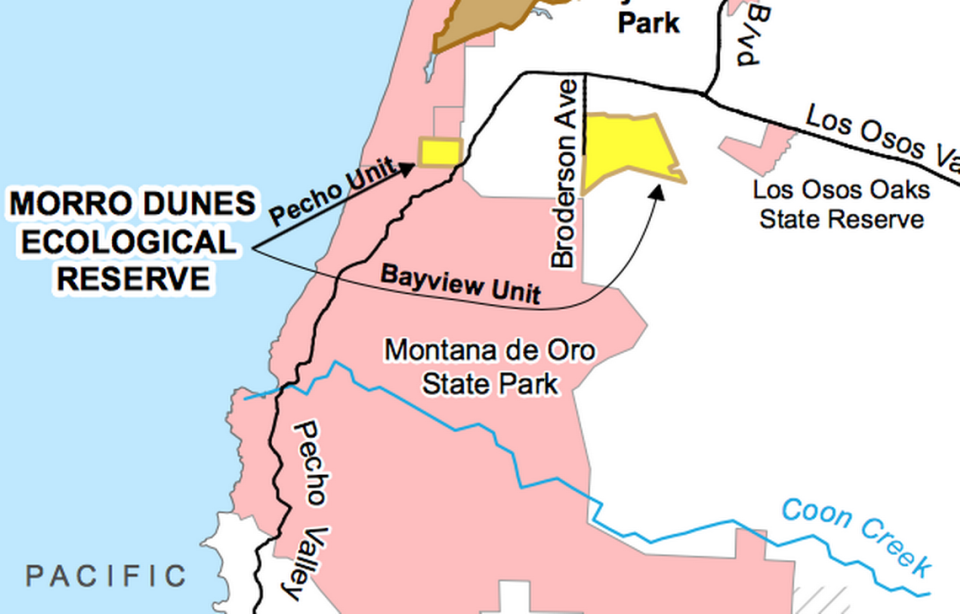Equestrians have been using this SLO County trail for decades. Why are they suddenly banned?
The Los Osos Community Advisory Council has unanimously backed historical use by equestrians to the east-west trail system at the edge of the Morro Dunes Ecological Preserve.
The preserve is just south of Highland in Los Osos near Broderson Avenue, which becomes a walking trail as it climbs into the preserve.
LOCAC members were advised of the issue last week with a presentation by former Cayucos science teacher Lisa Shinn, representing the local equestrian community and stables. Riders use the trail system to connect to Montana de Oro State Park.
Montana de Oro has been long used by equestrians, with the park offering some 61 miles of horse trails and a permanent horse camp that draws visitors from all over the West. Shinn noted the visitors have a beneficial impact on the local economy. In the state park, riders share the use of trails with hikers and bike riders.
The ecological preserve, founded in 1983, is overseen by the state Department of Fish and Wildlife. The agency’s website says equestrians are not allowed within the preserve. Indeed, in the past year, the agency posted a “Horses Prohibited‘‘ sign at one entrance to the trail system.
The whole trail system passes through multiple jurisdictions from private lands, BLM-managed land, the Fish and Wildlife Preserve and state park land. Much of the familiar foothill landscape that rises south of Los Osos is under BLM jurisdiction, which has no horse use restrictions.

Shinn argues that Fish and Wildlife put up the signs while offering no public hearing or notice. The equestrian community hopes to continue to access the corridor connecting the eastern horse stables to Montana de Oro without being “pushed onto the streets.”
Fish and Wildlife Lands Program Manager Bob Stafford explains the agency’s position.
“CDFW doesn’t allow horses on Morro Dunes Ecological Reserve because of negative impacts to habitat and wildlife species such as the federally endangered Morro shoulderband snail. The reserve is on a stabilized dune system, which is especially susceptible to disturbance, particularly by horses and mountain bikes, which are both prohibited. Historically, some horseback riders have created new trails on the property, which also causes environmental damage. The property that CDFW manages is 250 acres and restoring its trails is the primary mitigation measure listed in the Los Osos Habitat Conservation Plan. Horses have always been prohibited on the property, but dogs on leash are allowed.”
The horse riders point out they have used the connecting path that crosses the Broderson hiking trail for the past 50 years.
The group argued that Fish and Wildlife can offer some restricted use as it does in 10 state-run ecological preserves in California where horses are allowed.
Shinn added that the horse community offers trail maintenance crews in Montana de Oro. They ride alongside hikers, some with dogs on leashes where allowed, and share the trails, she said. They have a courteous relationship for the most part.
Dogs are not prohibited within the ecological preserve itself, but they are banned in the state park.
In the Fish and Wildlife preserve, placement of no horses signs has caused confusion and “friction with hikers.”
Shinn presented a map of the trail system that runs from the polo field east of town, then east of the Baywood Heights area before reaching the 183-acre ecological preserve. When it reaches the preserves, it skirts the edge behind Highland Avenue homes before it exits the preserve heading west. With no lifting of the restrictions, the corridor is blocked.
Shinn called for the public hearing to clear up the rules.
What appears to be an issue is the soon-to-be adopted Habitat Conservation Plan for Los Osos where community input may offer more public discussion.
John Lindt is editor of the news service Sierra2thesea.net and a member of the Los Osos Community Advisory Council.

